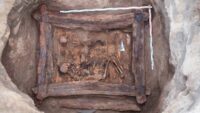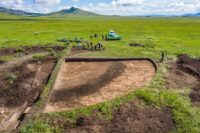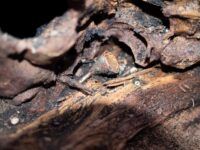 The skeletal remains of a richly adorned woman and a young child have been discovered in a burial mound in the Chinge-Tey archaeological site of Siberia. Grave goods found include gold earrings, an iron knife, an engraved wooden comb connected by a leather loop to a bronze mirror and a rare gold pectoral piece in a crescent shape. The burial dates to the 6th century B.C. when the valley was occupied by the Scythian Alda-Bielsko culture.
The skeletal remains of a richly adorned woman and a young child have been discovered in a burial mound in the Chinge-Tey archaeological site of Siberia. Grave goods found include gold earrings, an iron knife, an engraved wooden comb connected by a leather loop to a bronze mirror and a rare gold pectoral piece in a crescent shape. The burial dates to the 6th century B.C. when the valley was occupied by the Scythian Alda-Bielsko culture.
The mound is no longer a mound today, damaged to the point of being almost leveled, and was only detected thanks to aerial laser scanning that  spotted the circular structure more than 80 feet in diameter. Archaeologists excavated the former mound and discovered a wooden burial chamber in the center. The heavy, elaborate chamber was built on a framework of interlocking beams with a wooden floorboards and topped with three layers of beams to form a roof. The skeletons of a woman aged around 50 years old and a child two or three years old were inside the chamber.
spotted the circular structure more than 80 feet in diameter. Archaeologists excavated the former mound and discovered a wooden burial chamber in the center. The heavy, elaborate chamber was built on a framework of interlocking beams with a wooden floorboards and topped with three layers of beams to form a roof. The skeletons of a woman aged around 50 years old and a child two or three years old were inside the chamber.
The Chinge-Tey site is in the Turano-Ujukska Valley which has been ycleped the “Siberian Valley of the Kings” because of the proliferation of large burial mounds packed with rich grave goods that have been discovered there.
“A particularly interesting monument was the golden pectoral, a crescent or moon-shaped ornament hanging at the neck” – noted in an interview with PAP the head of the Polish part of the expedition, Dr. Łukasz Oleszczak from the Jagiellonian University in Krakow. He emphasized that such objects, known from burial mounds in southern Siberia, have so far been found almost exclusively in men’s graves.
“They were considered a symbol of belonging to some social group, caste, perhaps warriors – men at least. Placing him in a woman’s grave is a very interesting departure from this custom. It certainly proves the unique role of the deceased in the community of inhabitants of the Valley of the Kings” — believes the archaeologist.
At the same time, he pointed out that the woman was buried in the central part of the tomb located in the immediate vicinity of the great mound belonging to – as researchers believe – the prince of nomads. “It seems that, like the other dead buried in this mound, she belonged to the princely retinue,” said Oleszczak.
 There are traces of even more grave goods, bronze objects buried around the mound. A few pieces have been found — a bronze ice ax, animal-shaped figurines — using a metal detector, but archaeologists believe there were many more than were scattered during agricultural work at the site in the 20th century.
There are traces of even more grave goods, bronze objects buried around the mound. A few pieces have been found — a bronze ice ax, animal-shaped figurines — using a metal detector, but archaeologists believe there were many more than were scattered during agricultural work at the site in the 20th century.
The Chinge-Tey site is in the ‘Turano-Ujukska Valley’? OK, maybe it really is, but would anyone find it? :confused:
The river referred to is the “U(j/y)uk” (Russian: Ую́к), and Aržan/ Arzhan (Аржан, locally Аржаан) is a site of early Scythian kurgan burials in the Tuva Republic, Russia. It is on a high plateau traversed by the Uyuk. “Turan”, however, (Russian: Тура́н; Tuvan: Туран) is a nearby town and apparently the administrative center of Piy-Khemsky District.
The Scythian “Alda-Bielsko” culture seems to be a bit on the “Polish” side 😉 , as the “Aldy-Bel” culture (Алды-бельская культура is part of Uyuksk culture (Уюкская культура культура), an “Iron Age culture of Scytho-Siberian horse nomads in the area of Tuva in southern Siberia, dated to the 7th to 3rd centuries BC”.
As the ‘OpenStreetMap’ project, at least in greater detail, seems a bit patchy over there, we will probably never know the exact ‘Chinge-Tey’ spot, but in general “Arzha(a)n” and all is definitely worth a closer check-up.
——–
“[Arzhan 1] was first explored by a joint German and Russian archaeological expedition from 2000 to 2004. They found the royal couple, sixteen murdered attendants, and 9,300 objects. 5,700 of these artifacts were made of gold, weighing a Siberian record-breaking twenty kilograms. The male, who researchers guess was some sort of king, wore a golden torc, a jacket decorated with 2,500 golden panther figurines, a gold-encrusted dagger on a belt, trousers sewn with golden beads, and gold-cuffed boots. The woman wore a red cloak that was also covered in 2,500 golden panther figurines, as well as a gold hilted iron dagger, a gold comb, and a wooden ladle with a golden handle. The couple was buried together, suggesting that the woman was killed to keep the king company in the afterlife. The tomb also had thousands of beads, including over four hundred made of Baltic amber.”
en.wikipedia.org/wiki/Arzhan
en.wikipedia.org/wiki/Aldy-Bel_culture
journals.openedition.org/archeosciences/2193#tocto1n1
brewminate.com/kurgans-ancient-burial-mounds-of-scythian-elites-in-the-eurasian-steppe/
——–
PS: Sing along at youtu.be/0mV024phm3M :boogie: